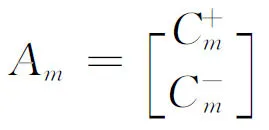碳纳米管非均匀氢等离子体微波吸收的数值模拟
2016-01-08刘保星,彭志华,谢凝钰等
碳纳米管非均匀氢等离子体微波吸收的数值模拟
刘保星,彭志华,谢凝钰,谢卫平,胡林华,张亚楠
(南华大学数理学院,湖南 衡阳 421001)
摘要:提出碳纳米管非均匀氢等离子体薄膜的层状介电模型,探讨等离子体密度分布对碳纳米管氢等离子体微波吸收的影响,运用转移矩阵法求解电磁波的传播方程,计算不同条件下碳纳米管氢等离子体薄膜在0~30 GHz频段的微波衰减系数。随着氢等离子体中自由电子密度分布非均匀性系数a的增加,微波衰减吸收峰值|Attmax|和强烈微波吸收的频宽均明显增大,吸收峰向高频方向移动。结果表明,增大等离子体密度分布的非均匀性,能显著改善碳纳米管氢等离子体薄膜的微波吸收性能。
关键词:碳纳米管;氢等离子体;层状介电结构;转移矩阵法;微波吸收
中图分类号:TB 383.2
基金项目:湖南省自然科学
作者简介:刘保星(1989-),男,山东济宁人,南华大学数理学院教师,硕士研究生。
通讯作者:彭志华(1962-),男,湖南邵东人,博士,教授,硕士生导师。
作者简介:蒲斌斌(1992-),男,甘肃定西人,陇西县首阳中学教师。
Numerical Simulation for Microwave Absorption of Non-homogeneous Hydrogen Plasma in Carbon Nanotubes
LIU Bao-xing,PENG Zhi-hua,XIE Ning-yu,XIE Wei-ping,HU Lin-hua,ZHANG Ya-nan
(School of Mathematics and Physics,University of South China,Hengyang,Hunan 421001,China)
Abstract:A layered structure model is proposed for microwave dielectric property of non-homogeneous hydrogen plasma in carbon nanotubes film.The influences of non-homogeneous density distribution of hydrogen plasma on microwave absorption of hydrogen plasma in carbon nanotubes films are investigated.Using the transfer matrix method for solving electromagnetic wave propagation equation,the microwave attenuation coefficients of the film are calculated in the frequency range of 0~30 GHz under different conditions.It is found theoretically that with the increase of hydrogen plasma non-homogeneity coefficients a,the maximum attenuation absorption |Attmax| and the frequency bandwidth of strong microwave absorption by the film increases markedly.The absorption peak shifts towards the high frequencies withincreasing.The numerical results show that as the non-homogeneity degree of the hydrogen plasma increases,the absorption of microwave energy will be enhanced in carbon nanotube films.
Key words:carbon nanotube;hydrogen plasma;layered dielectric structure;transfer matrix method;microwave absorption
1引言
现代军事隐身和民用微波防护对吸波材料提出了越来越高的要求。质量轻、力学性能好、具有特殊电磁性能的碳纳米管及其复合材料的合成,为吸波材料开辟了一个新的领域[1-30]。初步研究表明,碳纳米管氢等离子体是具有广泛应用前景的微波吸波与屏蔽材料。
本文在课题组对碳纳米管均匀氢等离子体微波吸收特性研究成果[16-19]的基础上,深入探讨了碳纳米管薄膜中氢等离子体分布的非均匀性对微波吸收的影响。研究结果对于碳纳米管氢等离子体微波吸收剂的优化设计和制备很有意义。
2理论模型
考虑到碳纳米管薄膜对氢气物理吸附的边缘效应[31],将碳纳米管氢等离子体薄膜视为层状介电结构的介质。薄膜的介电特性在薄膜平面的Y轴和Z轴方向上是均匀的,用ε表示薄膜的电容率,则ε/Z=0,ε/Y=0。而薄膜的介电特性在垂直薄膜平面的X轴方向近似于分层分布。将碳纳米管氢等离子体薄膜沿X轴方向划分为N等份,当N足够大时,可认为每层介质的介电特性是均匀的,如图1所示。

图1 碳纳米管氢等离子体薄膜的层状介电模型

(1)
上式中,v是入射微波的频率、νe为氢等离子体中电子碰撞的有效频率,氢等离子体频率
设碳纳米管氢等离子体薄膜中自由电子的密度分布函数为
(2)
其中n0为碳纳米管氢等离子体的平均自由电子密度,a表示氢等离子体中自由电子密度分布的非均匀性。a越大,自由电子密度分布的非均匀程度越高。
(3)
m=1,2,3…,N
用k表示波数,则对应于Xm-1 (4) 在该薄层介质中,电场传播方程为 (5) 而入射电磁波在碳纳米管非均匀氢等离子体薄膜中的能量衰减为[16] (6) 其中: (7) (8) 3数值计算及分析 (9) 设 (10) 运用转移矩阵可得 (11) 其中 (12) (13) 当N取值足够大时,即可得到出射微波参数Am的精确解。 设d=0.01m,n0=2.181×1017·m-3,ve=22.0 GHz,对于不同的a值,计算得到碳纳米管氢等离子体薄膜在0~30 GHz频率范围内的微波衰减系数,如图2所示。 取a=1.25,在v=2.63 GHz处有最大衰减吸收|Attmax|=37.24 dB·cm-1。取a=1.05和a=1.125,衰减吸收峰分别出现在2.50 GHz处和2.56 GHz处,对应的|Attmax|分别为33.82 dB·cm-1和35.89 dB·cm-1。当氢等离子体中自由电子密度分布的非均匀性系数a从1.05增大到1.25时,衰减吸收超过30.00 dB·cm-1的频宽从3.11 GHz(1.11~4.22 GHz)增加到11.26 GHz(0.50~11.76 GHz)。显然,随着a的增大,衰减吸收峰向高频方向移动。当a=1(即氢等离子体中的自由电子密度均匀分布)时,在v=2.45 GHz处有衰减吸收峰值|Attmax|=31.26 dB·cm-1。模拟结果表明,等离子体密度分布非均匀程度的增大有利于碳纳米管氢等离子体薄膜对微波的吸收。 图2 a取不同值时,碳纳米管氢等离子体薄膜的微波衰减系数随入射波频率变化的关系 4结论 基于碳纳米管氢等离子体薄膜层状介电模型假设,应用转移矩阵法,数值模拟了碳纳米管非均匀氢等离子体的微波吸收特性。当碳纳米管氢等离子体密度非均匀性系数a从1增加到1.25时,衰减吸收峰值|Attmax|从31.26 dB·cm-1增加到37.24 dB·cm-1,微波衰减系数超过30.00 dB·cm-1的频宽从2.79 dB·cm-1[16]增加到11.26 dB·cm-1。增大等离子体密度分布的非均匀性系数a,能显著提高碳纳米管氢等离子体薄膜的微波吸收性能。取a=1(即氢等离子体中的自由电子密度均匀分布)和n0=2.181×1017·m-3,在2.45 GHz处有衰减吸收峰值|Attmax|=31.26 dB·cm-1,数值结果与已获得的实验数据[9,11]相吻合。 参考文献: [1]Grimes C A,Dickey E C,Mungle C.Effect of purification of the electrical conductivity and complex permittivity of multiwall carbon nanotubes.J Appl Phys,2001,90(08):4134-4137. [2]Roberts J A,Imhol T,Ye Z.Electromagnetic wave properties of polymer blends of single wall carbon nanotubes using a resonant microwave cavity as a probe.J Appl Phys,2004,95(08):4352-4356. [3]Ting T H,Jau Y N,Yu R P.Microwave absorbing properties of polyaniline/multi-walled carbon nanotube composites with various polyaniline contents.Appl Surf Sci,2011,258(07):3184-3190. [4]Singh B P,Bharadwaj P,Choudhary V,et al.Enhanced microwave shielding and mechanical properties of multiwall cabon nanotubes anchored carbon fiber felt reinforced epoxy multiscale composites.Appl Nanosci,DOI:DOI 10.1007/s13204-013-0214-0,2013. [5]Savi P,Miscuglio M,Giorcelli M,et al.Analysis of microwave absorbing properties of epoxy MWCNT composites.Progr Electromagn Res Lett,2014,44:63-69. [6]Lin H,Zhu H,Guo H,et al.Microwave-absorbing properties of Co-filled carbon nanotubes.Mater Res Bull,2008,43:2697-2702. [7]Zheng Z,Xu B,Huang L,et al.Novel composite of Co/carbon nanotubes:Synthesis,magnetism and microwave absorption properties.Solid State Sci,2008,10:316-320. [8]Chen J,Du X C,Zhang W B,et al.Synergistic effect of carbon nanotubes and carbon black on electrical conductivity of PA6/ABS blend.Compos Sci Technol,2013,81:1-8. [9]Wadhawan A,Garrett D,Perez J M.Nanoparticle-assisted microwave absorption by single-wall carbon nanotubes.Appl Phys Lett,2003,83(13):2683-2685. [10]Imholt T J,Dyke C A,Hasslarcher B.Nanotubes in microwave fields:Light emission,intense heat,outgassing,and reconstruction.Chem Mater,2003,15:3969-3970. [11]Naab F,Dhoubhadel M,Holland W,et al.The Role of Metallic Impurities in the Interaction of Carbon Nanotubes with Microwave Radiation.In:Proceedings of the 10th International Conference on Particle Induced X-ray Emission and Analytical Applications.Portoroz,Slovenia,2005,601.1-601.4. [12]Tooskia S P.Sense toxins/sewage gases by chemically and biologically functionalized single-walled carbon nanotube sensor-based microwave resonator.J Appl Phys,2010,107:014702. [13]Moradia A.Comment on“Microwave attenuation of hydrogen plasma in carbon nanotubes”.J Appl Phys,2010,107:066104. [14]Zhihua P,Jingcui P,Yua O.Complex permittivity and microwave absorption properties of carbon nanotubes/polymer composite:A numerical study.Phys Lett A,2008,372:3714-3718. [15]Zhihua P,Jingcui P,Yanfeng P,et al.Complex conductivity and permittivity of single-walled carbon nanotubes/polymer composite at microwave frequencies:A theoretical estimation.Chin Sci Bull,2008,53(22):3497-3504. [16]Zhihua P,Jingcui P,Yua O.Microwave absorbing properties of hydrogen plasma in single-walled carbon nanotubes.Phys Lett A,2006,359:56-60. [17]Zhihua P,Jingcui P,Yanfeng P,et al.Investigation of the microwave absorbing mechanisms of HiPco carbon nanotubes.Physica E,2008,40:2400-2405. [18]Zhihua P,Xueyu G,Yanfeng P,et al.The effects of static magnetic field on microwave absorption of hydrogen plasma in carbon nanotubes:A numerical study.Chin Phys B,2012,21(07)078102. [19]彭志华,彭延峰,宁艳桃,等.碳纳米管磁化氢等离子体薄膜的微波吸收特性研究.材料科学与工艺,2012,20(03):145-148. [20]彭志华,彭景翠,欧玉,等.碳纳米管微波损耗机理的探讨.功能材料,2006,37(04):621-623. [21]彭志华,彭延峰,宁艳桃,等.碳纳米管磁化氢等离子体薄膜的微波吸收特性研究.材料科学与工艺,2012,20(03):145-148. [22]彭志华,彭延峰,宁艳桃,等.碳纳米管的本征微波吸收特性研究.河南科学,2010,28(12):1526-1529. [23]沈曾民,赵东林.镀镍碳纳米管的微波吸收性能研究.新型炭材料,2001,16(01):1-4. [24]毕红,吴先良,李民权.镀钻碳纳米管/环氧树脂基复合材料的制备及其微波吸收特性研究.宇航材料工艺,2005,35(02):34-37. [25]廖宇涛,张兴华.多壁碳纳米管电磁参数的研究和吸波性能模拟.材料导报,2006,20(03):138-140. [26]赵东林,沈曾民.含碳纳米管微波吸收材料的制备及其微波吸收性能研究.无机材料学报,2005,20(03):608-612. [27]沈曾民,杨子芹,赵东林.碳纳米管/ABS树脂基复合材料的力学性能和雷达波吸收性能的研究.复合材料学报,2003,20(02):25-28. [28]李聃,李泉注,张先锋.定向生长的多壁碳纳米管2~18 GHz复介电常数与复磁导率谱.无机材料学报,2004,(19):166-169. [29]张增富,罗国华,范壮军.不同结构碳纳米管的电磁波吸收性能研究.物理化学学报,2006,22(03):296-300. [30]王志强,张振军,范壮军,等.碳纳米管/三元乙丙橡胶复合材料吸波性能的研究.材料导报,2010,24(07):26-28. [31]Dobruskin V K.Contribution of the edge effect to physical adsorption in micropores of activated carbons.Carbon,2002,40(05):659-666. [责任编辑:冯浩英文编辑:刘彦哲]










